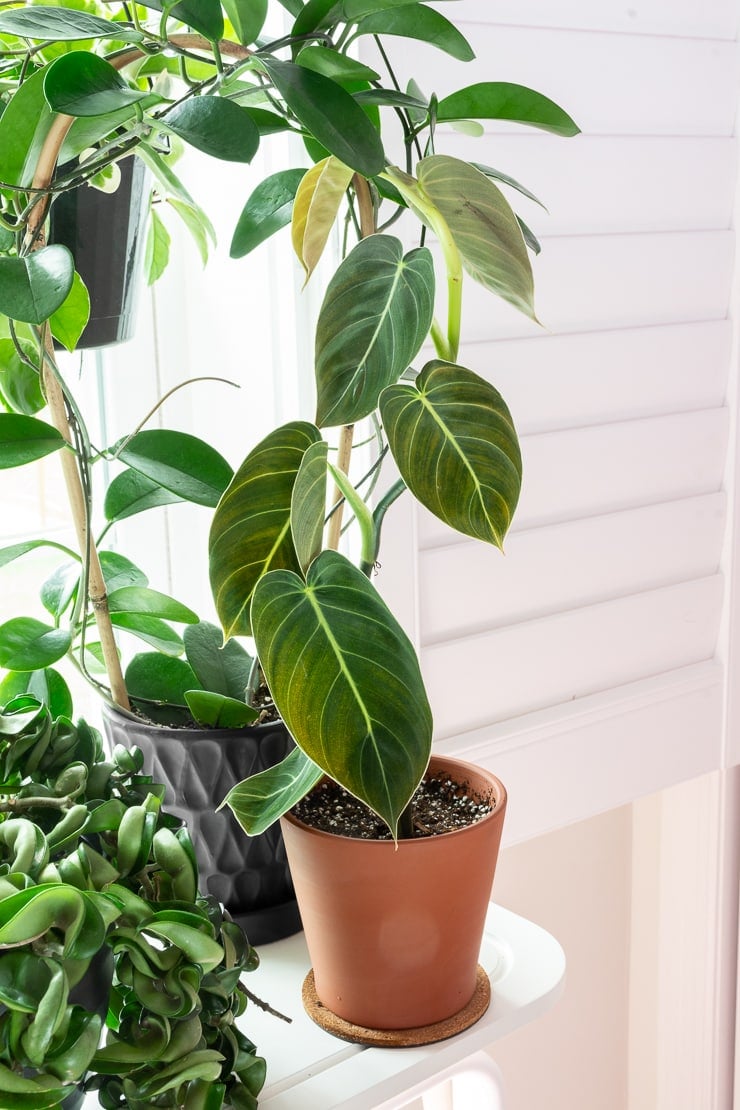Philodendron melanochrysum care is no more challenging than most other similar tropicals. Learn how to help this climbing plant thrive!
All about philodendron melanochrysum care as a houseplant
I’m excited to write about the philodendron melanochrysum today—I have been wanting to get my hands on this plant for a while, so when I got the chance to get one, I jumped at it!
This pretty tropical climber reminds me a lot of the philodendron micans with its similarly velvet-like leaves. However, melanochrysum has thick, beefy stems that allow the plant to grow straight up. The leaves a lot get a lot larger, but they are still pretty young on mine.
- Philodendron melanochrysum care overview
- What is a melanochrysum and where is it from?
- Are micans and melanochrysum the same?
- What are the ideal light conditions?
- What is the best soil?
- How often do I water a philodendron melanochrysum?
- What are the best temperature and humidity levels?
- What is its growth rate and should I fertilize it?
- Are there any pest issues?
- How to propagate a melanochrysum cutting

Philodendron melanochrysum care overview
- Tropical climber with velvet-like leaves and thick stems that support upright growth.
- Leaves can grow up to 2 feet, starting light green and darkening.
- Prefers bright indirect light indoors; dappled sunlight or shade outdoors.
- Direct sunlight can scorch its leaves, while insufficient light can cause the plant to become leggy.
- Use a well-draining soil designed for houseplants to help prevent root rot and aid in oxygen delivery to the roots.
- Allow the top few inches of soil to dry out before watering again.
- Prefers warm temperatures and is not frost hardy.
- Adaptable to various humidity levels, but higher humidity is preferred.
- Will eventually benefit from a support structure like a moss pole.
- Propagate the plant using stem cuttings.
What is a melanochrysum and where is it from?
Philodendron melanochrysum is a type of philodendron—melanochrysum means “black gold,” I believe in Greek.
“Black gold” comes from the fact that the super dark mature leaves on a melanochrysum develop speckles that almost look golden. It grows on the wet Andean foothills of Colombia.
When the heart-shaped leaves first unfurl, they are a lighter green with yellow-brown undertones. Eventually the leaves darken to a gorgeous deep green, and as the plant matures, the leaves elongate to an upwards of 2 feet long (in ideal growing conditions…see the monster below!).

Are micans and melanochrysum the same?
No, philodendron micans and melanochrysum are not the same. The leaves do look relatively similar. However, micans can usually be found trailing from a hanging basket, while melano is a climber.
The stems on the melano are also thicker than the micans, which have longer, thin, jointy stems. The leaves on the micans also stay somewhat smaller, while the melanochrysum can have very large leaves on a mature plant.
They are both gorgeous, though. Dark green, velvet-finish leaves. If you like that look, micans are relatively easy to find at nurseries and even big box garden centers! Melanochrysums can sometimes be found at local nurseries, but more often than not you’ll have more luck ordering online or buying from a local plant buy/sell/trade hobbyist.


What are the ideal light conditions?
Indoors, keep your philodendron melanochrysum in bright indirect light. For me, that usually means near one of my sunniest windows. Watch for peak afternoon sun to ensure it isn’t too much.
Melanochrysum cannot do too much direct sunlight. It will burn the leaves. I have found that it’s incredibly rare for my plants to burn indoors no matter how close to a sunny window they are. But your home might be brighter than mine.
If you have your melanochrysum outdoors for the spring and summer, make sure you have it in dappled sunlight at the most. Shade is fine. Under a covered patio or the leaves of a large tree that shields it from most of the sun.
Some direct morning sun is probably okay, but again—keep an eye on the foliage to make sure you don’t need to scale that back. Once you scorch the leaves, you can’t reverse that.
On the other hand, if you have the plant indoors and it isn’t getting enough light, it will start getting leggy. This is not a low-light plant. Signs of a leggy plant are new leaves decreasing in size and the space between the leaves extending as the plant reaches for the light.

What is the best soil?
A very well-draining soil is key to philodendron melanochrysum care. You can’t appropriately water your melano without the right soil. Look for a soil labeled “well-draining” or “houseplant” soil. (For more on houseplant soil and soil amendments, check out my houseplant soil 101 guide!)
When I got my plant, it was shipped to me bare root. I mixed up some soil using a well-draining houseplant mix as the base. Then I threw in some more chunky perlite, some shredded coco coir, and some coconut husk chunks.
You could also add in some orchid bark to help with drainage and aeration, but I didn’t have any. The perlite and coconut husk chunks help out with this, too.
If your soil is too dense, it will prevent the water from flowing through it and out of the drainage holes. This can lead to root rot. The chunky soil also helps to get oxygen to the roots, an essential part of the plant’s healthy development.

How often do I water a philodendron melanochrysum?
There’s not much else to say about watering! If you get your soil mixture right and you let the top few inches of soil dry out before you water it again—you’ll be good to go!
One common issue for beginners is overwatering, which can lead to root rot. Remember, it’s crucial to let the top few inches of soil dry out between waterings. Even if you have well-draining soil, there is a risk of overwatering the plant. The roots will stay too wet, and the leaves will begin yellowing off.
Underwatering could lead to the leaves wilting and dying off. The leaves could also start browning and just generally looking sad. Look to your soil’s moisture level if you have an issue and need help identifying if you are over or under watering.

What are the best temperature and humidity levels?
Philodendron melanochrysum prefers warmer temperatures—it’s a tropical plant, though. It is not cold or frost hardy, so you can’t leave it outdoors unless you live somewhere that doesn’t get below the 50s in the winter. So, not where I live!
Melanochrysum does well in most normal household temperatures, though. And it should do well in a range of humidity levels, too. Always watch for signs of stress due to dry air when you’ve got tropicals indoors, though.
It will do best with higher humidity levels, though. You can add a humidifier to the space you have the plant in. I currently have mine in a glass greenhouse cabinet for added humidity and will likely bring it outside for the summer.

What is its growth rate and should I fertilize it?
Philodendron melanochrysum is an average grower as far as speed goes. With optimal care and something to climb, melano can push out several new leaves every year.
Speaking of something to climb—since this is a vining plant, it will appreciate something to climb. Its stem is rather thick and can help it stand up on its own, but something like a moss pole doesn’t hurt.
It will also help stabilize the plant and anchorage larger leaf growth. To help your plant along, you can give it something like a Liqui-Dirt organic fertilizer (affiliate link) to replenish nutrients. Keep in mind, though, that freshly repotted plants probably have some sort of slow-release fertilizer in the soil you used.

Are there any pest issues?
I have not had any pest issues with my philodendron melanochrysum yet. However, it is susceptible to a variety of the normal household pets:
- Fungus gnats, which aren’t necessarilly harmful to your plant but can be signs of other issues like overwatering. Read more about what causes fungus gnats and how to get rid of them.
- Mealybugs, which often show themselves as little cotton-looking nest masses on the undersides of leaves and the areas where the leaves meet the stems.
- Scale, which often shows itself as a sticky brown residue on or around the plant.
- Spider mites, which aren’t really spiders. They are tiny mites that crawl around your plant and suck the life out of it. A tell-tale sign of spider mites is fine webbing, usually around the tips of leaves or where the leaves meet the stems.
- Thrips, which are the worst. I have a whole novel on them. Read more about how to get rid of thrips on houseplants.

How to propagate a melanochrysum cutting
If you have a solid philodendron melanochrysum care routine, you will probably want to try your hand at trimming a piece off and propagating it eventually. I have propagated countless philodendrons at this point, and it’s pretty much the same process—let’s walk through it.
First take a cutting that has a few leaves and a couple of nodes. Those little bumps you can see in the below picture of a stem. You could also remove a cutting and then remove the bottom-most set of leaves to expose growth points.
Once you take a cutting, you can put it in water to root it. Or you can put it in a mixture of sphagnum moss and perlite, which helps to develop strong roots (read more about rooting in moss). Water rooting is easy, but it doesn’t always produce the strongest roots.
If you like using water and don’t want to deal with moss and perlite, you can also try to use LECA. LECA are clay balls that work together with water to help you develop strong roots—more about LECA propagation here.
Whichever route you choose to root the cutting, monitor the root growth. Once you have roots that are a few inches long, you can transplant the cutting to soil. Keep the humidity high and the soil moist for a few weeks.
When you sense a bit of resistance pulling the cutting from the soil, you can begin treating your melano as normal. You have a new philodendron melanochrysum plant 🙂


In conclusion…
I hope you’ve found this guide to be helpful! Caring for a philodendron melanochrysum is rewarding. As the leaves grow in size and deepen in color, you’ll find that any extra steps you have to take to keep this plant happy are well worth it!
Remember that each growing environment is unique. So use the information I’ve provided in this article to help you find the most appropriate approach for you and your melano. Happy planting!
Pin my philodendron melanochrysum care guide!


Brittany is a seasoned DIY home and garden expert, running a creative brand since 2014 that inspires others with approachable plant care guides, woodworking tutorials, and decor projects. She is a certified project manager and has completed extensive coursework in the art and science of growing your own plants. Her work has been recognized by major publications, and she routinely collaborates with fellow DIY industry leaders—but her favorite thing to do is inspire you! Learn more about her here.

Leave a comment